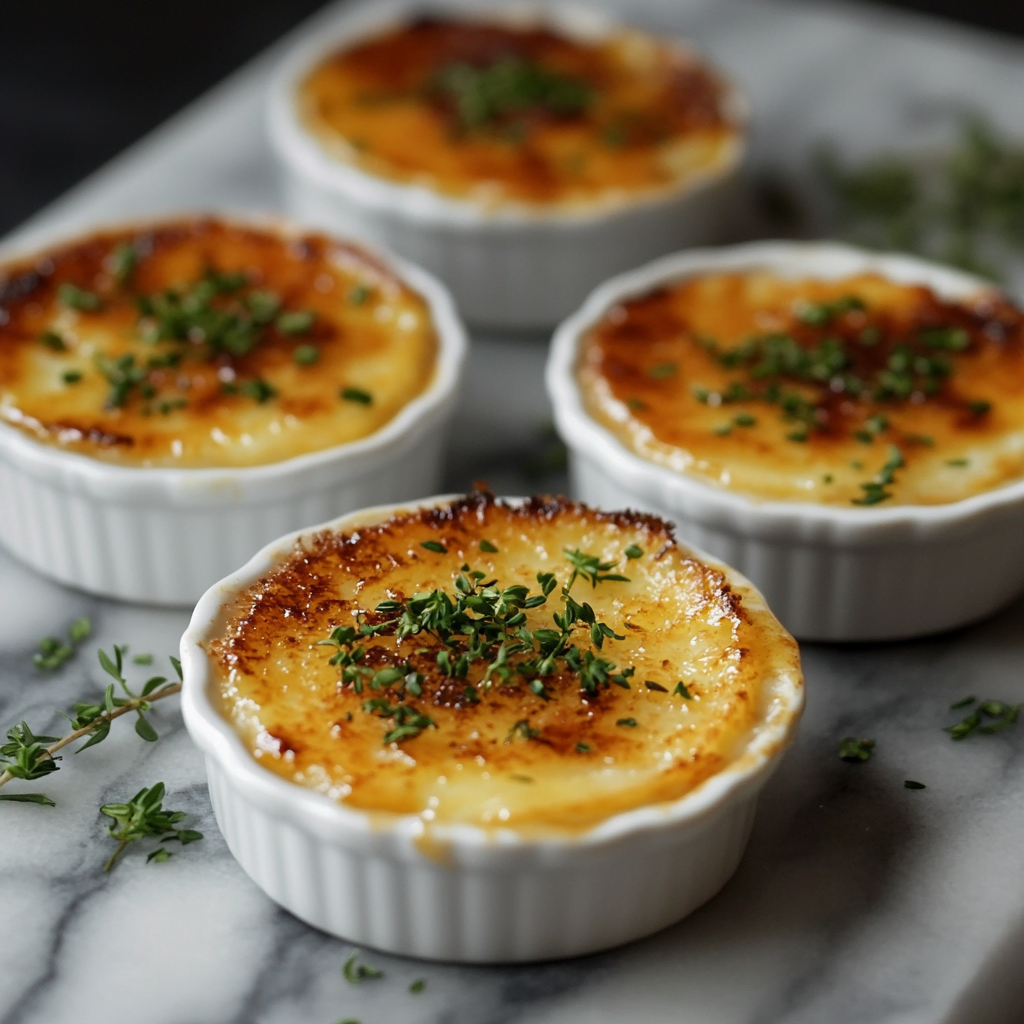Crème brûlée is a dessert that epitomizes sophistication and indulgence. This classic French treat, with its velvety custard base topped with a crisp, caramelized sugar crust, is a favorite among dessert lovers. The magic of crème brûlée lies in the contrast between the creamy custard and the crunchy topping, making the process of caramelization crucial to achieving perfection. In this guide, we’ll explore the science behind caramelizing sugar, the tools you’ll need, and the techniques to create the perfect brûlée crust and how to caramelize brulee.
Introduction to Caramelizing Crème Brûlée
The hallmark of a perfect crème brûlée is its crackly, caramelized sugar topping. Achieving this requires more than just sprinkling sugar on the custard; it involves understanding the process of caramelization and how to apply heat correctly to achieve the desired result.
Caramelizing sugar is both an art and a science. It’s not just about melting sugar but also about controlling the heat to create a golden-brown, glassy crust that shatters under a spoon. If you’re new to the process or looking to refine your technique, mastering the science of caramelization is essential. For a deeper dive into the chemical reactions involved, explore The Science of Caramelization.
Understanding the tools at your disposal is equally important. From kitchen torches to broilers, each method offers its own advantages and challenges. For a beginner-friendly guide on using a kitchen torch, check out How to Use a Kitchen Torch.
The Science Behind Caramelization
To achieve the perfect caramelized sugar topping on your crème brûlée, it’s crucial to understand the science behind caramelization.
Maillard Reaction vs. Caramelization
While both the Maillard reaction and caramelization involve browning, they are distinct processes. The Maillard reaction occurs between amino acids and reducing sugars, contributing to the browning of meats and baked goods. In contrast, caramelization is the oxidation of sugar, which involves breaking down sugar molecules at high temperatures to create complex flavors and a rich, golden color.
Sugar Caramelization: The Chemical Process
Caramelization begins at around 320°F (160°C), where sugar starts to melt and break down. As the temperature rises, the sugar turns from clear to golden brown, releasing aromatic compounds that give caramel its distinctive flavor. The process continues until the sugar reaches the “hard crack” stage, at which point it becomes brittle and shatters easily.
Optimal Temperature for Caramelizing Sugar
For crème brûlée, the ideal temperature to achieve a perfect caramelized crust is between 350°F and 370°F (175°C to 190°C). At this range, the sugar melts evenly and forms a hard, glass-like surface without burning.
Essential Tools for Caramelizing Crème Brûlée
The tools you use can significantly impact the outcome of your crème brûlée. Here are the essential tools for achieving that perfect caramelized crust.
Kitchen Torch
The kitchen torch is the most common tool used for caramelizing crème brûlée. It allows for precise control over the heat, enabling you to caramelize the sugar evenly without overcooking the custard. To use a kitchen torch effectively:
- Hold the torch about 2-3 inches away from the surface.
- Move the flame in a circular motion to evenly distribute the heat.
- Keep the flame moving to prevent burning any single spot.
Broiler Method
If you don’t have a kitchen torch, you can use your oven’s broiler to caramelize the sugar. This method requires placing the custards on the top rack, close to the broiler element. The intense heat from the broiler will melt and caramelize the sugar, but you must watch closely to prevent burning.
Alternative Tools
Other tools that can be used for caramelizing include:
- Blowtorch: Similar to a kitchen torch but more powerful, often used in professional kitchens.
- Pre-caramelized Sugar: Toast the sugar in the oven before sprinkling it on the custard. This can create a more uniform crust but requires careful timing.
Types of Sugar for Caramelization
The type of sugar you use can greatly affect the texture and flavor of your caramelized crust. Here are the most common sugars used for crème brûlée:
Granulated Sugar
Granulated sugar is the traditional choice for crème brûlée. It melts evenly and creates a smooth, glassy crust. It’s readily available and provides a neutral flavor that complements the custard.
Brown Sugar
Brown sugar adds a deeper, more complex flavor due to its molasses content. However, it doesn’t melt as smoothly as granulated sugar and can result in a slightly grainier texture.
Superfine Sugar
Superfine sugar, also known as caster sugar, is finer than granulated sugar and melts more quickly. This can be beneficial if you’re looking to achieve a very smooth, even crust.
Specialty Sugars
For a unique twist, consider using flavored or colored sugars. These can add an extra layer of flavor and visual appeal to your crème brûlée. For example, vanilla-infused sugar can enhance the custard’s vanilla notes, while cinnamon sugar adds a warm, spicy kick.
For more guidance on selecting the right sugar, check out Choosing the Right Sugar for Crème Brûlée.
Step-by-Step Guide to Caramelizing Crème Brûlée
Now that you understand the science and have the right tools, it’s time to caramelize your crème brûlée. Follow this step-by-step guide to achieve the perfect caramelized sugar crust.
Preparing the Custard
Before you start caramelizing, ensure that your custards are fully set and chilled. The custard should be firm to the touch, with no jiggle in the center. Chilling the custard thoroughly ensures that it doesn’t overheat and curdle during the caramelization process.
Even Sugar Distribution
Sprinkle an even layer of sugar over the surface of each custard. The key to an even crust is in the distribution:
- Use a small sieve to dust the sugar evenly across the surface.
- Aim for a thin, uniform layer—about 1 to 2 teaspoons of sugar per ramekin.
- Tilt and rotate the ramekin to cover the entire surface with sugar.
Torching Technique
To achieve a perfect caramelized crust using a kitchen torch:
- Hold the torch at a 45-degree angle, about 2 inches away from the surface.
- Start at one edge and work your way around in a circular motion.
- Keep the flame moving to avoid burning any single spot.
- Watch for the sugar to melt, bubble, and turn golden brown.
Broiler Method
If using the broiler:
- Preheat the broiler to high and place the ramekins on the top rack.
- Watch closely as the sugar caramelizes—this can happen quickly, in 1-2 minutes.
- Rotate the ramekins if necessary to ensure even caramelization.
- Remove from the broiler as soon as the sugar turns a deep amber color.
Final Touches
After caramelizing, allow the custards to cool for a minute before serving. This gives the sugar a chance to harden into a brittle crust that will “crack” beautifully under a spoon.
Common Mistakes and How to Avoid Them
Even experienced bakers can encounter issues when caramelizing crème brûlée. Here are some common mistakes and how to avoid them.
Uneven Caramelization
Uneven caramelization can result in some areas being too dark while others remain undercooked. To avoid this:
- Ensure even sugar distribution.
- Keep the torch moving to prevent overheating any one area.
- Use a circular motion to evenly distribute the heat.
Burning the Sugar
Burning the sugar is a common mistake that can result in a bitter taste. To prevent this:
- Hold the torch at the correct distance (about 2 inches away).
- Keep the flame moving to avoid concentrating heat in one spot.
- If using a broiler, watch the custards closely and remove them as soon as the sugar reaches the desired color.
Sugar Crystallization
Sugar crystallization occurs when undissolved sugar forms crystals, creating a gritty texture. To prevent crystallization:
- Use superfine or granulated sugar, which dissolves more easily.
- Ensure the custard is completely chilled before caramelizing.
- Use a sieve to evenly distribute the sugar.
Not Achieving a Crackly Top
A common disappointment is when the sugar crust isn’t crisp enough. To achieve the perfect crackly top:
- Ensure the sugar layer is thin and even.
- Use the correct technique when torching, keeping the flame moving.
- Allow the caramelized sugar to cool and harden before serving.
Creative Twists on Traditional Caramelization
If you’re looking to elevate your crème brûlée, consider these creative twists on the traditional caramelization process.
Flavored Sugars
Experiment with flavored sugars to add an extra layer of complexity to your crème brûlée. Options include:
- Cinnamon Sugar: Adds a warm, spicy note that pairs well with the custard.
- Espresso Sugar: Infuses the sugar with a rich, coffee flavor.
- Vanilla Sugar: Enhances the custard’s natural vanilla flavor.
Layering Techniques
For a thicker crust, try layering the sugar:
- Apply a thin layer of sugar and lightly caramelize it.
- Add another layer of sugar and caramelize again.
- This creates a thicker, more substantial crust with multiple layers of caramel.
Torching Patterns
Get creative with your torching technique by creating decorative patterns on the sugar crust:
- Swirls: Move the torch in a swirling motion for a decorative effect.
- Stripes: Caramelize in straight lines to create a striped pattern.
- Spirals: Start at the center and work your way out in a spiral pattern.
FAQs
What Is the Best Sugar to Use for Caramelizing Crème Brûlée?
The best sugar for caramelizing crème brûlée is granulated sugar. It melts evenly and forms a smooth, crackly crust. For a finer texture, you can also use superfine sugar, which dissolves more quickly.
Can I Caramelize Sugar Without a Torch?
Yes, you can caramelize sugar without a torch by using your oven’s broiler. Place the custards on the top rack and watch closely as the sugar melts and caramelizes. This method can be trickier to control, so be sure to monitor the sugar closely to prevent burning.
Why Is My Sugar Burning Instead of Caramelizing Evenly?
If your sugar is burning instead of caramelizing evenly, it may be due to the torch being held too close or the flame being too concentrated in one area. Keep the torch at a distance of about 2 inches and move it continuously to ensure even caramelization.
How Do I Get the Sugar to Melt Evenly Without Clumping?
To get the sugar to melt evenly without clumping:
- Use superfine or granulated sugar for even distribution.
- Ensure the custard is fully chilled before caramelizing.
- Apply the sugar in a thin, even layer and use a sieve for better coverage.
Can I Use Alternative Sweeteners for Caramelization?
While traditional sugar is preferred for its melting properties, some alternative sweeteners like coconut sugar can be used for caramelization. However, they may result in a different flavor and texture. Experiment with small batches to find what works best.
Conclusion: Perfecting the Art of Caramelizing Crème Brûlée
Caramelizing the sugar on a crème brûlée is a skill that takes practice to perfect. By understanding the science behind caramelization, using the right tools, and following proper techniques, you can achieve a flawless, crackly sugar crust every time.
Whether you’re using a kitchen torch, broiler, or experimenting with flavored sugars, the key is to maintain control and keep an eye on the sugar as it caramelizes. With practice and attention to detail, you’ll master the art of caramelizing crème brûlée, delighting your guests with a dessert that’s as visually stunning as it is delicious.

